As much as I love Peter Reinhart’s Whole Grain Breads, I’ve only made a few recipes from the book. Instead, I’ve been busy using his techniques to adapt my old favorite bread recipes to whole wheat versions. While you can, in general, simply substitute up to half of the flour in a bread recipe with whole wheat, I guarantee that you’ll have better results if you use Reinhart’s trick.
Reinhart uses the same method for most of the breads in his book – about half of the whole wheat flour is combined with salt and liquid and the other half is combined with yeast and liquid. Both mixtures sit overnight before they’re mixed and kneaded into the dough. The resting time breaks down the long bran molecules, making the bread smoother, lighter, and sweeter – in short, more like a white bread.
The 100% whole wheat breads that I’ve tried from Reinhart’s book are truly exceptional. However, I guess I’m sort of a wimp about whole grains. I do like the flavor and texture of white bread, but of course I prefer the health factor of whole grain bread. Plus, I’m still interested in bread recipes outside of Reinhart’s book.
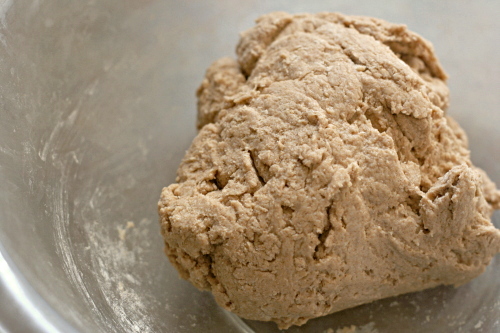 (the pre-dough before resting)
(the pre-dough before resting)
The solution is to mix up just one of Reinhart’s mixtures with whole wheat flour and let that rest overnight (or for around 8 hours), then continue with the recipe as written, mixing in the pre-dough. I’ve done this with all sorts of bread recipes – English muffins, pain ordinaire, light brioche buns, country crust bread, pizza crust.
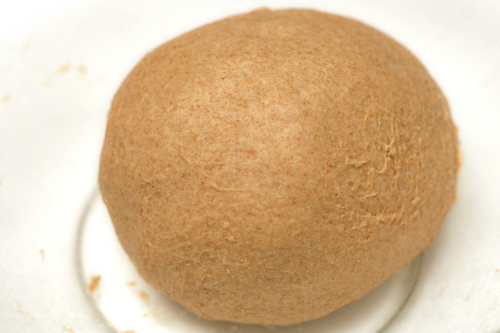 (the pre-dough after resting and a bit of kneading)
(the pre-dough after resting and a bit of kneading)
In all cases, I take half of the flour in the recipe and mix it with ¼ teaspoon salt for every 4 ounces of flour. Then I mix in enough liquid – whatever liquid the recipe calls for – to moisten the flour until it forms a dough. Most bread recipes call for about 16 ounces flour total, so the pre-dough is simply 8 ounces of whole wheat flour, ½ teaspoon of salt, and ¾ cup of water (or whatever liquid the recipe calls for). When the final dough is mixed, those ingredients are subtracted from the original recipe.
And every time, the result is essentially identical to an all-white version – the dough is smooth, elastic, and easy to work with. The bread is light and flavorful. And, I still get to play with an entire world of bread recipes. Win win win!
One year ago: Roasted Kale
Two years ago: Banana Walnut Pancakes
Printer Friendly Recipe
Whole Wheat Light Brioche Burger Buns (adapted from Smitten Kitchen and Peter Reinhart’s Whole Grain Breads)
Makes 8 buns
Pre-dough:
1¾ cups (8 ounces) whole wheat flour
½ teaspoon salt
¾ cup water
1. Mix all of the soaker ingredients together in a bowl for about 1 minute, until all of the flour is hydrated and the ingredients form a ball of dough.
2. Cover loosely with plastic wrap and leave at room temperature for 12 to 24 hours. (If it will be more than 24 hours, place the soaker in the refrigerator; it will be good for up to 3 days. Remove it 2 hours before mixing the final dough to take off the chill.)
Dough:
8 ounces (about 1⅔ cups) bread flour
1 teaspoon salt
2½ tablespoons unsalted butter, softened
pre-dough
¼ cup warm water
3 tablespoons warm milk
2 teaspoons instant yeast
2½ tablespoons sugar
1 large egg
extra flour or water for adjustments
egg wash: 1 tablespoon milk or 1 egg white or whole egg beaten with 1 tablespoon water
sesame seeds
1. If mixing with a stand mixer: Add the flour and salt to mixer bowl fitted with paddle attachment. Mix on low just to combine. Add the butter and mix on medium-low speed until the mixture resembles crumbs. Cut the pre-dough into about 12 pieces and add them to the flour mixture, tossing the pieces to coat (to keep them from immediately sticking back together). Replace the paddle attachment with the hook. Add the water, milk, yeast, sugar, and egg to the mixer bowl and mix on medium-low until combined, then continue kneading until smooth and elastic, 6-8 minutes. The dough should be just a bit loose and sticky; add flour if necessary.
If mixing by hand: In a large bowl, whisk flours with salt. Add butter and rub into flour between your fingers, making crumbs. Cut the pre-dough into about 12 pieces and add them to the flour mixture, tossing the pieces to coat (to keep them from immediately sticking back together). Add the water, milk, yeast, sugar, and egg and stir with a rubber spatula until a dough forms. Scrape dough onto clean, well-floured counter and knead, scooping dough up, slapping it on counter and turning it, until smooth and elastic, 8 to 10 minutes. The dough will be on the sticky side so it can be a bit messy, but keep in mind that the more flour you knead in, the tougher the buns will get. Try to leave them tackier than you would a round loaf.
2. Spray a bowl with nonstick spray; shape dough into a ball and place it in bowl. Cover bowl with plastic wrap or a damp towel and let rise in a warm place until doubled in bulk, one to two hours.
3. Line a baking sheet with parchment paper or a silicone mat. Divide dough into 8 equal parts. To shape each portion into an even round, gently pull the edges toward a pucker and pinch them together. Gently roll each into a ball and arrange them two to three inches apart on the prepared baking sheet. Cover loosely with a piece of plastic wrap lightly coated in nonstick spray (or a damp towel) and let buns rise in a warm place for about one hour.
4. Preheat oven to 400 degrees with rack in center. Brush egg wash on buns and sprinkle with sesame seeds. Bake, turning sheet halfway through baking, until tops are golden brown and an instant-read thermometer reads at least 185 degrees, about 15 minutes. Transfer to a rack to cool completely.
Printer Friendly Recipe
Whole Wheat Pain Ordinaire (adapted from Eric Treuille and Ursula Ferrigno’s Ultimate Bread and Peter Reinhart’s Whole Grain Breads)
Makes 1 loaf
Pre-dough:
1¾ cups (8 ounces) whole wheat flour
½ teaspoon salt
¾ cup water
1. Mix all of the soaker ingredients together in a bowl for about 1 minute, until all of the flour is hydrated and the ingredients form a ball of dough.
2. Cover loosely with plastic wrap and leave at room temperature for 12 to 24 hours. (If it will be more than 24 hours, place the soaker in the refrigerator; it will be good for up to 3 days. Remove it 2 hours before mixing the final dough to take off the chill.)
Dough:
1¾ cups (9½ ounces) all-purpose or bread flour
pre-dough
2 teaspoons instant yeast
⅔ cup water, room temperature
¾ teaspoon salt
1. Add the flour to a mixer bowl fitted with hook attachment (or a large bowl if mixing by hand). Cut the pre-dough into about 12 pieces and add them to the flour, tossing the pieces to coat (to keep them from immediately sticking back together). Add the water, yeast, and salt to the mixer bowl and mix on medium-low until combined (or stir with a rubber spatula), then continue kneading until smooth and elastic, 6-8 minutes (8-10 minutes if by hand). The dough should be soft but not sticky; add flour if necessary.
2. Lightly oil a large bowl and transfer the dough to the bowl, rolling it to coat with the oil. Cover the bowl with plastic wrap or a damp towel. Let rise until doubled in size, about 1½ to 2 hours.
3. Gently pat the dough into a rough rectangle. Fold the bottom third of dough, letter style, up to the center and press to seal, creasing surface tension on the outer edge. Fold the remaining dough over the top and use the edge of your hand to seal the seam closed and to increase the surface tension all over. Press evenly with the palms of both hands and roll the dough backward and forward until it is 10 inches in length. Line a pizza peel baking parchment. Place the loaf on the peel and lightly dust with flour. Cover loosely with plastic wrap or a damp towel.
4. Proof at room temperature for about 1 hour, or until the loaf has grown to about twice its original size. About half an hour into the second rise, place a baking stone on the bottom rack of the oven and preheat the oven to 500 degrees.
5. Using a very sharp knife or a serrated bread knife, cut 5 diagonal slashes, each about ¼ to ½-inch deep, across the top of the loaf. (Alternatively, cut one long slash that extends for the length of the loaf.)
6. Transfer the dough on the parchment to the baking stone. Close the oven and reduce the temperature to 450 degrees. Bake until golden brown and the temperature is at least 200 degrees at the center. Transfer the loaves to a cooling rack and cool for at least 1 hour before slicing and serving.
Printer Friendly Recipe
Whole Wheat Country Crust Bread (adapted from Betty Crocker and Peter Reinhart’s Whole Grain Breads)
Makes 1 sandwich loaf
Pre-dough:
1¾ cups (8 ounces) whole wheat flour
½ teaspoon salt
¾ cup water
1. Mix all of the soaker ingredients together in a bowl for about 1 minute, until all of the flour is hydrated and the ingredients form a ball of dough.
2. Cover loosely with plastic wrap and leave at room temperature for 12 to 24 hours. (If it will be more than 24 hours, place the soaker in the refrigerator; it will be good for up to 3 days. Remove it 2 hours before mixing the final dough to take off the chill.)
Dough:
1¾ cups (9½ ounces) unbleached flour
1 teaspoon table salt
¼ cup water, warm (110 degrees)
1 egg
2 tablespoons vegetable oil or unsalted butter, melted
¼ cup (1.75 ounces) granulated sugar
2 teaspoons instant yeast
1. Add the flour to mixer bowl fitted with hook attachment (or a large bowl if mixing by hand). Cut the pre-dough into about 12 pieces and add them to the flour, tossing the pieces to coat (to keep them from immediately sticking back together). Add the salt, water, egg, oil, sugar, and yeast to the mixer bowl and mix on medium-low until combined (or stir with a rubber spatula), then continue kneading until smooth and elastic, 6-8 minutes (8-10 minutes if by hand). The dough should be soft but not sticky; add flour if necessary.
2. Lightly oil a large bowl and transfer the dough to the bowl, rolling it to coat with the oil. Cover the bowl with plastic wrap or a damp towel. Let rise until doubled in size, about 1½ to 2 hours.
3. Form dough into loaf by gently pressing the dough into a rectangle, one inch thick and no wider than the length of the loaf pan. Next, roll the dough firmly into a cylinder, pressing with your fingers to make sure the dough sticks to itself. Turn the dough seam side up and pinch it closed. Finally, place dough in greased 9-by-5-by-3-inch loaf pan and press it gently so it touches all four sides of the pan.
4. Cover with plastic wrap or a damp towel; set aside in warm spot until dough almost doubles in size, about 45 minutes. Heat oven to 350 degrees.
5. Remove plastic wrap from loaf pan; place pan in oven. Bake until instant-read thermometer inserted at angle from short end just above pan rim into center of loaf reads 195 degrees, about 40 to 50 minutes. Remove bread from pan, transfer to a wire rack, and cool to room temperature. Slice and serve.
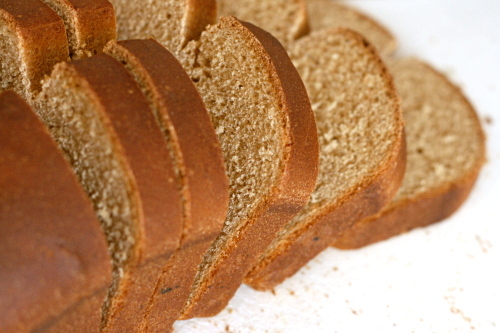
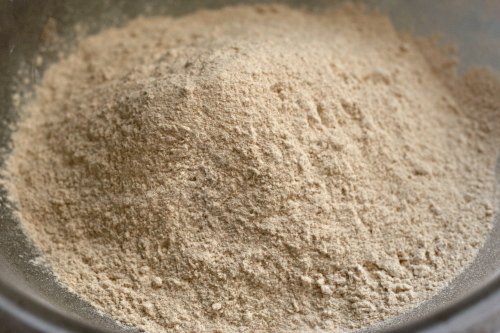
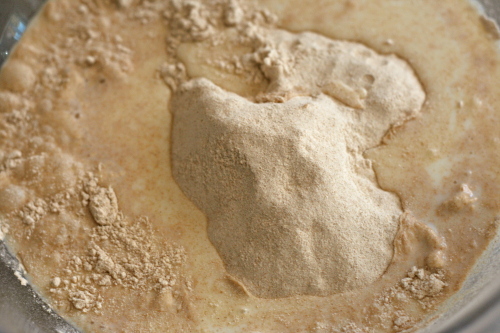
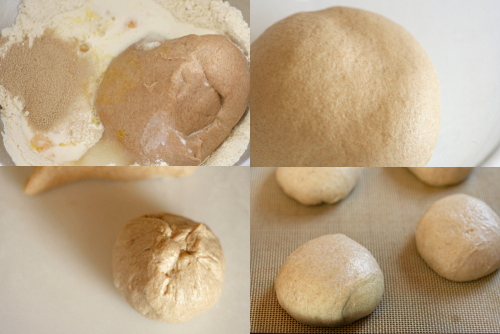
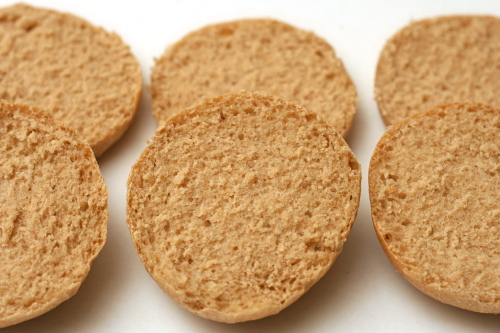
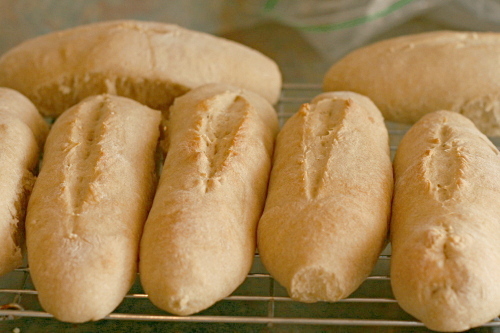






Oh so this is my next baking marathon project. Thanks! ;p
Actually, I did want a good whole wheat bun recipe since I made an awesome batch of veggie burgers. I was just too lazy to figure this out myself. =)
Thank you so much for posting this! I have made far too many super-dense whole wheat loaves and now I feel like all my problems are solved!
Thanks for the lesson on whole grain breads. This post is going to be a great reference for me. Can’t wait to try this method!
Bridget, I love all your posts, but I’d have to say that this is my very favorite post of yours yet!! I think I’m not just starring, but bookmarking. I always try to make whole wheat items and they don’t turn out “jsut right”. This is so great! I am LOOOVING the whole wheat country loaves too!! 🙂 Thank you!
Amazing tip! I’m going to try this with some gluten free bread too!
These are such great tips. I’m always on the lookout for good recipes to fit in more whole grains. Thanks for posting!
Thanks for the great tip, this is very useful indeed!
Well written and explained. Thank you thank you!
Wow, this has been such an informative and helpful post, and solves so many of the problems I’ve had with whole wheat! thanks so much. I’ve got my eye on the country crust/sandwich loaf first; will let you know how it turns out. thanks so much.
What a great tip! You may just have changed my life. Hehe. 🙂
Honestly, I like the 100% whole wheat breads. I was raised on them, so that probably helps. I love the idea of leaving the whole wheat flour to soak overnight. I used this method making Peter Reinhart’s cornbread (soaking the cornmeal in buttermilk overnight), and it produced the creamiest cornbread I’ve ever eaten. Heaven!
I will definitely be putting your idea to use. Thanks!
I love your posts!! This is great! I’m bookmarking this post for future reference.
This post is amazing! Thanks so much for sharing all of your tips. Seriously, you rock! 🙂 Bookmarking this one for future reference.
Hi Again,
You mentioned that you have used this technique succesfully in your pizza making, which I’d love to try. Were you able to sub in a full half of the flour for whole wheat? I ask only because when I link back to your pizza crust post, you mentioned that only 7 oz can be substituted, and I’m wondering if this was only in reference to making it without this new technique. Hope I haven’t confused you more! thanks!
amanda – I can see the confusion. I’ll update my pizza post with a link to this one, but, yes, using this technique, I can substitute half of the flour with whole wheat with no detriment to the crust. In contrast, previously (using a simple straight substitution) I could only substitute 1/3 of the flour with whole wheat, and the dough became far more elastic and difficult to work with, plus the resulting crust was slightly denser.
Bridget, you are the bomb!! Thank you so much for posting this; I am totally making the brioche buns soon.
Thank you! I’m sure this post will be a valuable reference to me time and time again!
Great, thank you so much! I’ve always had that too-dense issue with ww pizza crust, so this is exciting. will let you know how it turns out! i’ve got homemade goat cheese i’m just dying to spread on it…
Very informative post! I would love to make those brioche buns for our hamburgers in the summer.
OHMYGOD. I think I just found the golden ticket.
Thank you so much for posting this.
I love this post! I have now made the Pain Ordinaire and the crusty sandwich bread. They were both fabulous! Have you ever used 100% whole wheat flour in this method?
Thanks, what a great post. I have Reinhart’s book also but have not finished the intro. Do you find it necessary to read or can you just delve into the recipes. I do want to understand everything he says but just do not have the time. The recipes seem complex w/o having read the introduction though…
Sharon – I’ve heard other people say that about Reinhart’s Whole Grain Book, and I completely understand how you could get bogged down! But you definitely shouldn’t miss out on the recipes just because you can’t get through the intro right now. You can definitely jump to the recipes, just take it from someone who made this mistake: Trust Reinhart, not yourself! I made a couple recipes, found on blogs, before I bought the book, and I fudged a couple things because I thought I knew how to bake bread – but Reinhart knows more than me!
Also, there’s a recipe mixed into the intro section (it’s actually for his basic sandwich bread) that guides you through the steps in a lot of detail, so that might be the perfect way to ease yourself into the recipes.
What an absolutely fabulous post! Definitely going to bookmark and use these recipes. Starting RIGHT NOW!!
Made the hamburger bun recipe today. They’re so soft and fluffy, they’re actually a bit too soft to slice easily. Can’t wait to see how my hubby and children like them. The only changes I made were I used coconut oil instead of butter and used whole wheat bread flour. I ended up having to add 1/4 cup more flour, because the dough was so slack it wasn’t getting picked up by the dough hook. Also, the buns were done in 10 minutes. Too bad I didn’t double the recipe to make hotdog buns, too. I’ll definitely be bookmarking this page and making this recipe again. Thank you very much for sharing!
The soaking step is called an autolyse. Whole Wheat benefits from it because the bran is so thirsty, and the soaking softens the bran so it doesn’t cut the gluten later during kneading (great gluten development is key to a fluffy rise). For 100% whole wheat, I’ve combined *all* the flour and liquid and let sit overnight. For many recipes it’s also a good idea to increase the liquid by 20% (by weight) because whole wheat soaks up more liquid than white flour does.